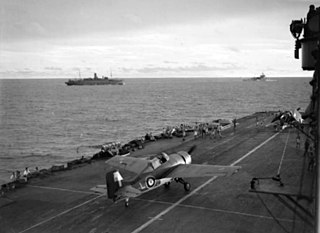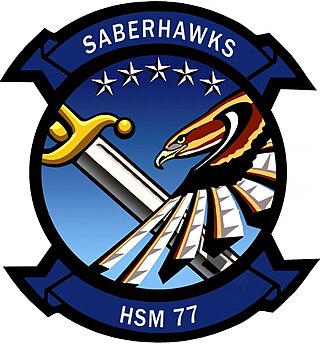
An aircraft carrier is a warship that serves as a seagoing airbase, equipped with a full-length flight deck and facilities for carrying, arming, deploying, and recovering aircraft. Typically, it is the capital ship of a fleet, as it allows a naval force to project air power worldwide without depending on local bases for staging aircraft operations. Carriers have evolved since their inception in the early twentieth century from wooden vessels used to deploy balloons to nuclear-powered warships that carry numerous fighters, strike aircraft, helicopters, and other types of aircraft. While heavier aircraft such as fixed-wing gunships and bombers have been launched from aircraft carriers, these aircraft have not landed on a carrier. By its diplomatic and tactical power, its mobility, its autonomy and the variety of its means, the aircraft carrier is often the centerpiece of modern combat fleets. Tactically or even strategically, it replaced the battleship in the role of flagship of a fleet. One of its great advantages is that, by sailing in international waters, it does not interfere with any territorial sovereignty and thus obviates the need for overflight authorizations from third-party countries, reduces the times and transit distances of aircraft and therefore significantly increases the time of availability on the combat zone.
The escort carrier or escort aircraft carrier, also called a "jeep carrier" or "baby flattop" in the United States Navy (USN) or "Woolworth Carrier" by the Royal Navy, was a small and slow type of aircraft carrier used by the Royal Navy, the Royal Canadian Navy, the United States Navy, the Imperial Japanese Navy and Imperial Japanese Army Air Force in World War II. They were typically half the length and a third the displacement of larger fleet carriers, slower, more-lightly armed and armored, and carried fewer planes. Escort carriers were most often built upon a commercial ship hull, so they were cheaper and could be built quickly. This was their principal advantage as they could be completed in greater numbers as a stop-gap when fleet carriers were scarce. However, the lack of protection made escort carriers particularly vulnerable, and several were sunk with great loss of life. The light carrier was a similar concept to the escort carrier in most respects, but was fast enough to operate alongside fleet carriers.
The United States Navy, United States Coast Guard, and United States National Oceanic and Atmospheric Administration (NOAA) use a hull classification symbol to identify their ships by type and by individual ship within a type. The system is analogous to the pennant number system that the Royal Navy and other European and Commonwealth navies use.

The Nimitz class is a class of ten nuclear-powered aircraft carriers in service with the United States Navy. The lead ship of the class is named after World War II United States Pacific Fleet commander Fleet Admiral Chester W. Nimitz, who was the last living U.S. Navy officer to hold the rank. With an overall length of 1,092 ft (333 m) and a full-load displacement of over 100,000 long tons (100,000 t), the Nimitz-class ships were the largest warships built and in service until USS Gerald R. Ford entered the fleet in 2017.

USS Abraham Lincoln (CVN-72) is the fifth Nimitz-class aircraft carrier in the United States Navy. She is the third Navy ship to have been named after the former President Abraham Lincoln. Her home port is NAS North Island, San Diego, California; she is a member of the United States Pacific Fleet. She is administratively responsible to Commander, Naval Air Forces Pacific, and operationally serves as the flagship of Carrier Strike Group 3 and host to Carrier Air Wing Nine. She was returned to the fleet on 12 May 2017, marking the successful completion of her Refueling and complex overhaul (RCOH) carried out at Newport News Shipyard. On 1 April 2019, USS Abraham Lincoln was deployed to the Middle East as the flagship for Carrier Strike Group 12 and Carrier Air Wing Seven assigned to her.

USS Constellation (CV-64) was a Kitty Hawk-class supercarrier and the third ship of the United States Navy to be named in honor of the "new constellation of stars" on the flag of the United States. One of the fastest ships in the Navy, as proven by her victory during a battlegroup race held in 1985, she was nicknamed "Connie" by her crew and officially as "America's Flagship".

USS Bennington (CV/CVA/CVS-20) was an Essex-class aircraft carrier in service with the United States Navy from 1944 to 1946 and from 1952 to 1970. She was sold for scrap in 1994.

USS Essex (CV/CVA/CVS-9) was an aircraft carrier and the lead ship of the 24-ship Essex class built for the United States Navy during World War II. She was the fourth US Navy ship to bear the name. Commissioned in December 1942, Essex participated in several campaigns in the Pacific Theater of Operations, earning the Presidential Unit Citation and 13 battle stars. Decommissioned shortly after the end of the war, she was modernized and recommissioned in the early 1950s as an attack carrier (CVA), eventually becoming an antisubmarine aircraft carrier (CVS). In her second career, she served mainly in the Atlantic, playing a role in the Cuban Missile Crisis. She also participated in the Korean War, earning four battle stars and the Navy Unit Commendation. She was the primary recovery carrier for the Apollo 7 space mission.

USS Forrestal (CVA-59), was a supercarrier named after the first United States Secretary of Defense James Forrestal. Commissioned in 1955, she was the United States' first completed supercarrier, and was the lead ship of her class. The other carriers of her class were USS Saratoga, USS Ranger and USS Independence. She surpassed the World War II Japanese carrier Shinano as the largest carrier yet built, and was the first designed to support jet aircraft.

The Yorktown class was a class of three aircraft carriers built for the United States Navy and completed shortly before World War II, the Yorktown (CV-5), Enterprise (CV-6), and Hornet (CV-8). They immediately followed Ranger, the first U.S. aircraft carrier built as such, and benefited in design from experience with Ranger and the earlier Lexington class, which were conversions into carriers of two battlecruisers that were to be scrapped to comply with the Washington Naval Treaty, an arms limitation accord.

Naval aviation is the application of military air power by navies, whether from warships that embark aircraft, or land bases.
The names of commissioned ships of the United States Navy all start with USS, for United States Ship. Non-commissioned, primarily civilian-crewed vessels of the U.S. Navy under the Military Sealift Command have names that begin with USNS, standing for United States Naval Ship. A letter-based hull classification symbol is used to designate a vessel's type. The names of ships are selected by the Secretary of the Navy. The names are those of states, cities, towns, important persons, important locations, famous battles, fish, and ideals. Usually, different types of ships have names originated from different types of sources.
A joint support ship (JSS) is a multi-role naval vessel capable of launching and supporting joint amphibious and airlift operations. It can also provide command and control, sealift and seabasing, underway replenishment, disaster relief and logistics capabilities for combined land and sea operations.
The structure of the United States Navy consists of four main bodies: the Office of the Secretary of the Navy, the Office of the Chief of Naval Operations, the operating forces, and the Shore Establishment.

An amphibious assault ship is a type of amphibious warfare ship employed to land and support ground forces on enemy territory during an amphibious assault. The design evolved from aircraft carriers converted for use as helicopter carriers. Modern designs support amphibious landing craft, with most designs including a well deck. Like the aircraft carriers they were developed from, some amphibious assault ships also support V/STOL fixed-wing aircraft and have a secondary role as aircraft carriers.

The United States Navy (USN) is the maritime service branch of the United States Armed Forces and one of the eight uniformed services of the United States. It is the largest and most powerful navy in the world, with the estimated tonnage of its active battle fleet alone exceeding the next 13 navies combined, including 11 allies or partner nations of the U.S. as of 2009. It has the highest combined battle fleet tonnage and the world's largest aircraft carrier fleet, with 11 in service, 1 undergoing trials, two new carriers under construction, and six other carriers planned as of 2024. With 336,978 personnel on active duty and 101,583 in the Ready Reserve, the U.S. Navy is the third largest of the United States military service branches in terms of personnel. It has 299 deployable combat vessels and about 4,012 operational aircraft as of July 18, 2023.

Aircraft carriers are warships that evolved from balloon-carrying wooden vessels into nuclear-powered vessels carrying many dozens of fixed- and rotary-wing aircraft. Since their introduction they have allowed naval forces to project air power great distances without having to depend on local bases for staging aircraft operations.

Helicopter Maritime Strike Squadron Seven Seven (HSM-77) "Saberhawks" is a United States Navy helicopter squadron based at Naval Air Facility, Atsugi, Japan. HSM-77 is attached to Carrier Air Wing Five and deploys aboard USS Ronald Reagan and air capable ships attached to Carrier Strike Group Five (CSG-5). The squadron was established as Helicopter Antisubmarine Squadron (Light) Forty Seven (HSL-47) on 25 September 1987 and was redesignated HSM-77 on 2 Apr 2009.

Coast Guard Squadron One, also known in official message traffic as COGARDRON ONE or RONONE, was a combat unit formed by the United States Coast Guard in 1965 for service during the Vietnam War. Placed under the operational control of the United States Navy, it was assigned duties in Operation Market Time. Its formation marked the first time since World War II that Coast Guard personnel were used extensively in a combat environment.

Carrier Strike Group Nine is a U.S. Navy formation. The group is one of six U.S. Navy carrier strike groups assigned to the U.S. Pacific Fleet. In 2004–09, it was based at Naval Base San Diego and its flagship was the Nimitz-class aircraft carrierUSS Abraham Lincoln (CVN-72).

















